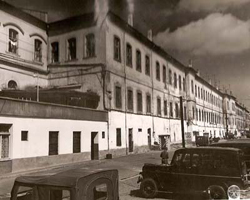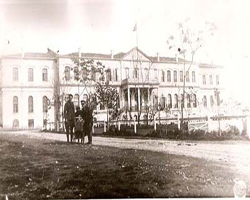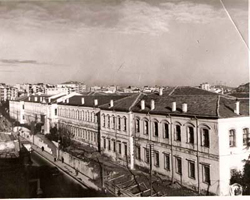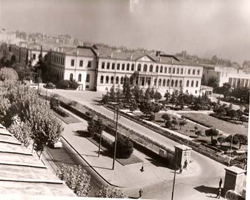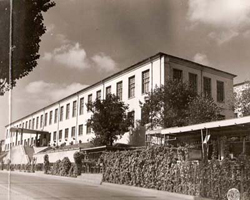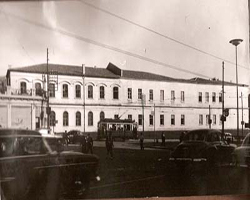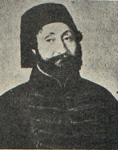The foundation of Military Museum , which is one of the leading museums of the world in terms of the richness of its collections, dates back to the 15th century, though not in the modern sense. After Istanbul was conquered by the Turks in 1453, the Saint Irene Church was organized as a 'Cebehane', an armory, in which valuable war armaments, tools and equipment were stored. In 1726, all the materials in Cebehane were reorganized and a new foundation, called 'Dar-ül Esliha', the Place of Arms, was established. The foundations of Turkish museology in modern sense were laid down in 1846 by the efforts of Artillery Marshall Ahmet Fethi Pasha and this date has become the foundation of Turkish museology and the Military Museum for the first time in real sense.
The spaces between the cloisters in the Saint Irene (a space closed on three sides and opening to outside with arches set on columns on one side) were turned into exhibition areas through closing them with showcases. In some of such spaces collections of old war arms, tools and equipment were exhibited while in others collections of archeological artifacts were displayed.
Shortly after Ahmet Fethi Pasha’s contributions, these collections in Saint Irene were called the 'Müzeyi Hümayun', the Imperial Museum , having the title “Museum” in its name for the first time. Subsequent to the formation of the museum organization, and especially upon an increase in the number of archeological artifacts, these artifacts were transferred to the 'Çinili Köşk', the Tiled Chalet, and the foundations of today's Archeological Museums in Istanbul were laid down.
Ahmet Muhtar Pasha enriched the arms collections with proclamations and official correspondence. With its library, cinema, shooting gallery, publications, costume house and the 'Janissary Band', a qualified museum conforming to the modern understanding of modern museology was created.
The Military Museum continued its activities in Saint Irene until 1940 and then suspended its activities for a while, considering that the Second World War may spread to Turkey as well. After the war risk had reduced, the artifacts stored in the Maçka Armory began to be displayed again in the Military School 's Gymnasium.
Because this building was found to be insufficient with time and did not allow any steps for improvement in the modern sense to be taken, it was decided that the old Harbiye building, with restoration works ongoing since 1966, would be used as the Military Museum and it was opened for visits on February 10, 1993 with a new arrangement.
The foundation of Military Museum , which is one of the leading museums of the world in terms of the richness of its collections, dates back to the 15th century, though not in the modern sense. After Istanbul was conquered by the Turks in 1453, the Saint Irene Church was organized as a 'Cebehane', an armory, in which valuable war armaments, tools and equipment were stored. In 1726, all the materials in Cebehane were reorganized and a new foundation, called 'Dar-ül Esliha', the Place of Arms, was established. The foundations of Turkish museology in modern sense were laid down in 1846 by the efforts of Artillery Marshall Ahmet Fethi Pasha and this date has become the foundation of Turkish museology and the Military Museum for the first time in real sense.
The spaces between the cloisters in the Saint Irene (a space closed on three sides and opening to outside with arches set on columns on one side) were turned into exhibition areas through closing them with showcases. In some of such spaces collections of old war arms, tools and equipment were exhibited while in others collections of archeological artifacts were displayed.
Shortly after Ahmet Fethi Pasha’s contributions, these collections in Saint Irene were called the 'Müzeyi Hümayun', the Imperial Museum , having the title “Museum” in its name for the first time. Subsequent to the formation of the museum organization, and especially upon an increase in the number of archeological artifacts, these artifacts were transferred to the 'Çinili Köşk', the Tiled Chalet, and the foundations of today's Archeological Museums in Istanbul were laid down.
Ahmet Muhtar Pasha enriched the arms collections with proclamations and official correspondence. With its library, cinema, shooting gallery, publications, costume house and the 'Janissary Band', a qualified museum conforming to the modern understanding of modern museology was created.
The Military Museum continued its activities in Saint Irene until 1940 and then suspended its activities for a while, considering that the Second World War may spread to Turkey as well. After the war risk had reduced, the artifacts stored in the Maçka Armory began to be displayed again in the Military School 's Gymnasium.
Because this building was found to be insufficient with time and did not allow any steps for improvement in the modern sense to be taken, it was decided that the old Harbiye building, with restoration works ongoing since 1966, would be used as the Military Museum and it was opened for visits on February 10, 1993 with a new arrangement.




